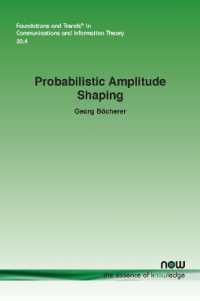- ホーム
- > 洋書
- > 英文書
- > Science / Mathematics
Full Description
Residential buildings consume about a quarter of all energy (including electrical and thermal) in industrialized countries and emit around 20% of the carbon emissions there. Older and outdated heating and cooling technology causes high energy demand and, depending on building type, secondary causes can include ventilation and lighting. Technology is available to mitigate high energy consumption, and to enable the use of renewable or environmentally friendly energy, partly generated locally.
This book, written by international experts from academia as well as industry, compiles and describes several key technologies available to reduce a residential building's energy consumption. Key themes include local energy generation, such as the use of sunlight to reduce heating needs, and photovoltaics for electricity. Case studies are included in most chapters to provide real-world context for the technologies described.
Contents
Chapter 1: Introduction and motivation
Chapter 2: Clean energy generation in residential green buildings
Chapter 3: Performance monitoring of a 60 kW photovoltaic array in Alberta
Chapter 4: Environmental and economic evaluation of PV solar system for remote communities using building information modeling: A case study
Chapter 5: Solar energy generation technology for small homes
Chapter 6: Numerical analysis of phase change materials for use in energy-efficient buildings
Chapter 7: Insulation materials
Chapter 8: Latent relationships between construction cost and energy efficiency in multifamily green buildings
Chapter 9: Secondary battery technologies: a static potential for power
Chapter 10: A critical review with solar radiation analysis model on inclined and horizontal surfaces
Chapter 11: Nature-based building solutions: circular utilization of photosynthetic organisms








